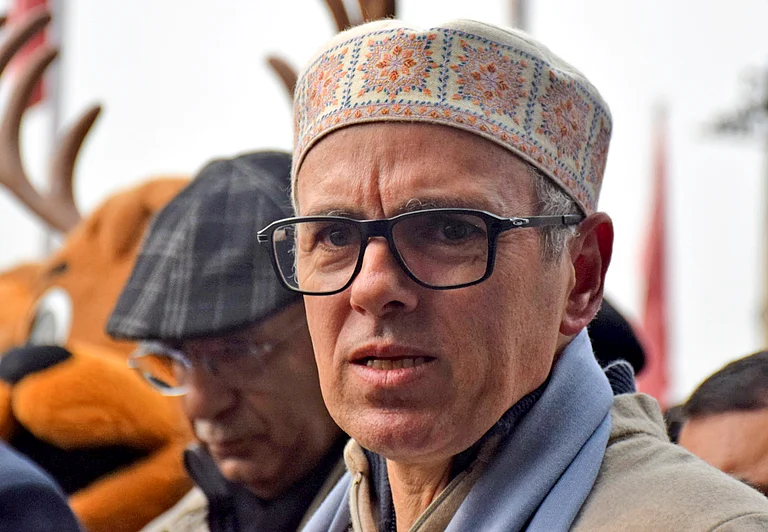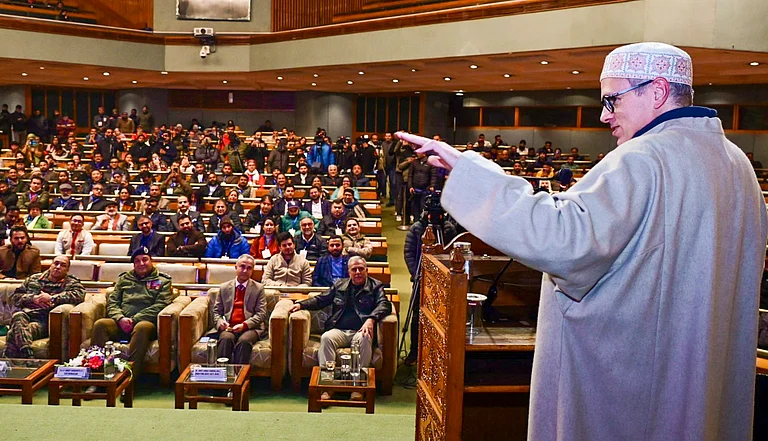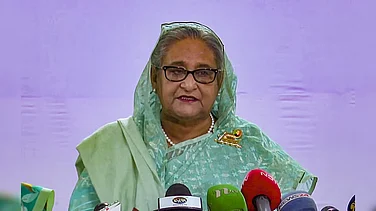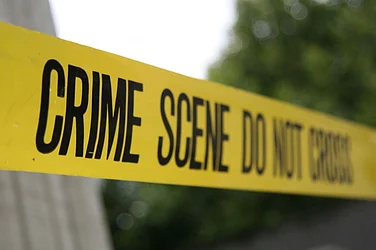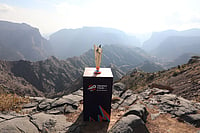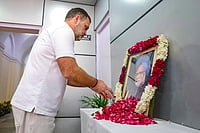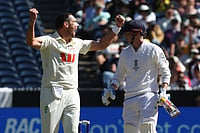The recent visit of US diplomats to Kashmir has drawn considerable attention, but it is not the first of its kind since the abrogation of Article 370 on August 5, 2019. Since then, the BJP government has facilitated several visits of foreign diplomats, including from the US, to the region. This latest visit stands out primarily because the US diplomats met with National Conference Vice President Omar Abdullah. The BJP has labelled this meeting as a conspiracy, accusing the NC of being involved in schemes against India, especially with elections near. However, the party seems to forget that the US diplomats also met the BJP leader in the Valley.
On August 16, the US diplomats met at the Peoples Conference Sajjad Lone. They later met National Conference Vice President Omar Abdullah at his Gupkar residence. The delegation included Minister-Counselor for Political Affairs Graham Mayer, First Secretary Gary Applegarth, and Political Counselor Abhiram Ghadyalpatil. Member of Parliament and senior leader Aga Ruhullah Mehdi also attended the meeting. “Discussions covered a wide range of issues concerning Jammu and Kashmir and the region at large,” the NC said in a brief statement. Since Ruhullah Mehdi has taken a strong stance against the abrogation of Article 370 and has been consistently asking for its restoration, his presence in the meeting triggered the BJP, which has accused the NC of “scheming with whites” to win the election. However, the party seems to forget that US diplomats also met BJP leader Hina Bhat and Apni Party leaders.
The NC says Abdullah asked the US delegation to remove the travel advisory for its citizens travelling to Kashmir. In July this year, the US updated its travel advisory for Jammu and Kashmir to ‘Level 4’ (Do Not Travel) designating the region among “high-risk areas”, thus urging American nationals to avoid the region.
After the abrogation of Article 370, the government invited and escorted foreign envoys to Kashmir. The first such visit occurred on January 1, 2020, when most mainstream political leaders, including former Chief Ministers Omar Abdullah and Mehbooba Mufti, along with hundreds of others, were detained under the Public Safety Act and were lodged in different sub-jails.
In January 2020, a team of 15 envoys, including US Ambassador to India Kenneth I. Juster, visited Srinagar for a two-day visit to Jammu and Kashmir. The envoys were brought in on a chartered aircraft and landed at the technical airport, from where they were taken directly to the army cantonment for a briefing.
Along with the US Ambassador, envoys from Vietnam, South Korea, Niger, Nigeria, Morocco, Guyana, Argentina, the Philippines, Norway, the Maldives, Fiji, Togo, Bangladesh, and Peru were part of the two-day government-guided trip.
The delegation was first taken to the Badamibagh army base, where they were briefed by a team of top army officers. Later, they had a luncheon meeting with a group of former legislators headed by former Minister Altaf Bukhari, including Ghulam Hassan Mir, Rafi Mir, Abdul Rahim Rather, Abdul Majeed Padder, Hilal Shah, Javed Beg, and Shoaib Lone. These later formed the Apni Party. The delegation had also met with some media personnel.
At that time Congress party accused the government of adopting double standards by resorting to “guided tours” for foreign envoys while not allowing Indian politicians to visit Jammu and Kashmir as senior Congress leaders were denied access to Kashmir. The National Conference had issued a statement expressing disappointment with the way foreign envoys were brought to the Valley to endorse “the central government's claims of normalcy.”
On February 10 and 11, 2020, envoys from 25 countries, mostly from the European Union, visited Srinagar. The envoys from Germany, France, Canada, Afghanistan, the Czech Republic, Cyprus, New Zealand, Mexico, Italy, Austria, Uzbekistan, Azerbaijan, Kenya, Poland, and Hungary stayed at the Lalit Hotel in Srinagar and later enjoyed a Shikara ride on Dal Lake. During this visit, then-Afghanistan’s envoy to India, Tahir Qadiry, was notably quoted. Qadiry tweeted, “We Afghans claim that we are Mehman-Navaz (hospitable), but the Kashmiris are definitely so too. Interacted with a bunch of young people here.”
The third such visit took place in February 2021 when a large number of European diplomats visited Kashmir. During their visit, they were also made to meet some editors of newspapers and journalists. On this visit, the group of foreign envoys interacted with District Development Council (DDC) representatives. The delegation included representatives from Malaysia, Bangladesh, Senegal, and Tajikistan, as well as envoys from Brazil, Italy, Finland, Cuba, Chile, Portugal, the Netherlands, Belgium, Spain, Sweden, Kyrgyzstan, Ireland, Ghana, Estonia, Bolivia, Malawi, Eritrea, and Ivory Coast. During these visits, the diplomats did not meet with National Conference and People's Democratic Party leaders.
As the third G20 Tourism Working Group meeting was held from May 22 to May 24, 2023 in Srinagar, Jammu and Kashmir, a number of delegations participated. While China abstained from the meeting on the grounds that it opposed holding any kind of meeting in what it called a “disputed territory”, Saudi Arabia, Oman, Turkey, and Egypt also refused to participate. Although not part of the G-20, Oman and Egypt received special invitations to the meeting.
The G20 meeting was one of the most significant international events held in Jammu and Kashmir since the abrogation of Article 370. By hosting this event, the Union government aimed to demonstrate that most major world powers endorsed its move. During the G20 meeting, a group of around 60 foreign delegates from 27 countries started a city tour after a yoga session in the morning. They visited the Mughal gardens on the Dal Lake, including the Pari Mahal built by Mughal Prince Dara Shikoh. Several delegates teed off on the lush green fairways of the Royal Spring Golf Course at the foothills of the Zabarwan hills.
Again, on August 22, 2023, US diplomats including Graham Mayer met Lieutenant Governor Manoj Sinha at Raj Bhawan in Srinagar. The visit didn’t get much attention.
In the latest visit, the US diplomats also met P Stobdan, the former Indian ambassador to Kyrgyzstan. Stobdan, who hails from the Ladakh region and is one of the top strategic thinkers in India, wrote on social media that Graham Mayer, Minister Counselor for Political Affairs of the US Embassy in New Delhi, called him on August 28.
Political analyst Luv Puri, who has authored two books on J&K, says, “The visit of mid-level U.S. diplomats to Srinagar is a normal diplomatic exercise of a significant country, which incidentally is now India’s strategic ally, to stay abreast of the events in the country where they are serving.”
“J&K elections have always commanded national as well as international attention,” he adds.
“It can be said that the US has taken an interest in J&K since independence and apart from mid-level functionaries of the state department the visits of Ambassadors had been common. And whenever diplomats come as part of their mandate, they meet a cross-section of the society to make a collective assessment of the situation and report back to their capital,” Puri adds. “Indian diplomats working in Washington DC and other western democracies do the same and, visit states as well and do call upon the important stakeholders in the US States and send their reports to South Block,” he adds.
Americans have been actively involved in Kashmir since 1948. American diplomats have regularly visited Kashmir Valley since 1990 meeting separatist leaders and other civil society actors. They stopped meeting separatists over a decade ago. In the mid-1990s U.S. diplomat Robin Raphel was a known name in the Valley among separatist circles.
However, the most influential American visit to the valley took place in 2011 when US Senator John McCain visited Ladakh and Srinagar. At that time, the government spokesman said the US senator held discussions “on various important issues” with Chief Minister Omar Abdullah and Governor N.N. Vohra in Srinagar. The senior Republican senator was accompanied by two foreign policy advisers and diplomats from the US embassy in New Delhi. When McCain met Governor Vohra, Lt Gen KT Parnaik, the then General Officer Commanding-in-Chief (Northern Command), and Lt Gen SA Hasnain, the then Commander of the army's Srinagar-based 15 Corps, were also present.







